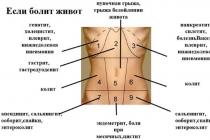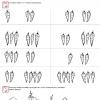Whether it's the first pregnancy, or already the fourth, a woman usually starts to listen to her body anyway as the expected date of birth approaches. Various harbingers of childbirth warn of their imminent onset: lowering of the abdomen and easier breathing, divergence of the pelvic bones, a decrease in fetal motor activity, a feeling of pressure in the lower abdomen, discharge of the mucous plug, outflow of amniotic fluid, and others.
Most confusion, confusion and difficulties in nulliparous women cause contractions. A few weeks before the birth, training, not real contractions may occur. And with the onset of the birth process, true contractions occur, as a result of which the cervix begins to open. By the way, it is by the degree of its disclosure that obstetricians will judge the woman’s readiness for the birth of a child and how much time is left. On average, within one hour, the cervix opens by 1 cm. In total, it should open by 10 cm.
How do fights start?
Contractions are called painful contractions of the uterine muscles that accompany a woman's pregnancy or childbirth. During the period of bearing a child, such sensations can occur for two reasons: the probable onset of a spontaneous miscarriage or the process of preparing the mother's body for the upcoming birth. In the first case, cramping pains in the lower abdomen are often accompanied by other dangerous signs of a threatened miscarriage (in particular, the appearance of bleeding of varying intensity and color from the genital tract).
In the second case, a woman feels something similar to real labor pains, only these false contractions are much less intense (light), are episodic, can arise and disappear without any regularity. If the contractions intensify, cause sharp unbearable pain, last more than 1 minute, or are accompanied by other dangerous signs, and especially if the time for childbirth has not yet arrived, then it is urgent to see a doctor.
The pain during real contractions is undulating in nature: it starts weaker, then spreads to a wider area and intensifies, later gradually fades away and does not bother the woman until the next “wave” occurs.
True contractions do not stop after a recent start. On the contrary, over time, they begin to increase momentum: they repeat more often and more pronounced, pain during the contraction gradually intensifies, the duration of the contraction increases, and the interval between episodes of contractions noticeably decreases. At the same time, no relief methods that help with false contractions (taking a warm shower, walking around the room, changing body position, drinking water) do not work. By this time, things in the hospital should already be collected.
When should you go to the hospital?
Many women prefer to go to the hospital in advance to eliminate any possible risks and feel more relaxed and protected. This mostly applies to primiparas and those who have had severe complications in the past. However, many pregnant women prefer to stay at home until the last moment, where they feel absolutely safe and comfortable. And such a choice is fully justified if the woman is healthy, the pregnancy went well and there are no risk factors. However, you need to know when the time to go to the hospital has come:
- contractions are repeated at regular intervals (but do not wait until they are shorter than 7-8 minutes: the farther the hospital, the earlier you need to leave - optimally, when the contractions are repeated every 10-15 minutes);
- one contraction lasts approximately 30 seconds or about a minute (if longer - hurry up!);
- contractions became quite painful (or very noticeable compared to the period they started).
Do not worry that you will not have time to get to the maternity hospital: the period of contractions is quite long: for primiparas, it averages 10-12 hours, and for multiparous women - up to eight hours.
In the meantime, the contractions have just begun and are still infrequently repeated, call your doctor (if you agreed that he would take the birth), go to the shower and get ready. It is better to go to the maternity hospital with your own transport, if there is such an opportunity, of course, as a passenger, not a driver. In this case, obstetricians recommend taking a reclining position.

It should be noted that during the second or more births, it is necessary to go to the maternity hospital with the appearance of true contractions, without waiting for their intensity and frequency to increase. There is a tendency for repeated births to be more rapid, and therefore it is better not to risk it: there are fairly high chances that the second birth will be faster than the first, and the third faster than the second. The same is true for multiple pregnancies. In addition, in some cases it is necessary to go to the maternity hospital earlier than usual situations.
You need to go to the hospital urgently when:
- real contractions started at less than 37 weeks;
- the amniotic fluid has completely departed (they do not leak, but immediately in large quantities), even if labor does not occur, that is, contractions do not begin; at the same time, it is necessary to remember the time when the waters broke, and pay attention to their appearance (transparent, cloudy, green);
- in the leaking amniotic fluid there are blood impurities;
- vaginal bleeding has begun (not to be confused with the passage of a mucous plug, which may normally contain streaks of red or brown blood);
- uterine activity (false contractions) does not stop within two days, and real contractions do not begin;
- contractions are very painful, and the uterus does not relax in between;
- contractions last more than a minute, and the interval between them is less than 7 minutes;
- with the onset of contractions, the child began to move very actively and / or his movements cause severe pain to the mother;
- against the background of contractions, it is spinning in the head, darkens or blurs in the eyes, the head hurts a lot;
- sharply increased blood pressure;
- urination became impossible.
What do you need to take with you to the hospital?
It is unlikely that you will start packing your bag to the hospital when you already need to go there. Ideally, things should be collected in advance, and for convenience - divided into three packages: prenatal, postnatal and discharge. It is better to sign each of the packages, indicating in the note the contents (just in case), as well as a few of your comments (instructions to the husband, reminders to the mother, etc.).

If it so happened that things were not collected, and the contractions did not just start, but started rather rapidly, that is, it is better to go to the hospital right away, then the most important thing that you should never forget about is the documents: passport, exchange card and medical insurance policy. Even without these documents, the medical staff is obliged to accept you, but in this case, the woman is placed in the department of unexamined patients, where there is a huge risk of contracting all kinds of infections. And therefore, in no case do not forget to take the listed documents with you, and in the last prenatal days without them, it’s generally better to leave the house without a foot!
If the fees to the hospital take place in extreme conditions, then you should grab a mobile phone, a nightgown, washable slippers, socks, a towel, a bottle of water. Everything else will be delivered to you later.
Of course, it is better to discuss in advance, without haste, the issue of preparing things for the maternity hospital with the doctor taking delivery (if there is such an agreement) or the medical staff of the maternity ward of your choice. Each such institution has its own rules: in some of them there is a strictly regulated list of things necessary for receipt, in others you can take things outside this list with you, after agreeing on the permissible ones. In the second case, you can look on the Internet for what you need to take with you to the hospital - various possible lists of things that other moms took with them - and make your own maternity package.
In general, no matter what and how you go to give birth, we wish you peace of mind and self-confidence. This is the most important thing now: remember to relax, breathe properly, save energy for the period of attempts and listen to the instructions of the doctors. Everything will be fine!
Especially for - Larisa Nezabudkina
Every woman, especially pregnant for the first time, should be able to distinguish contractions from false attempts and pain. Indeed, at this moment, the cervix begins to open, as a result of which the birth canal expands. Feeling the path to freedom, the child strives outside. Therefore, it is important to meet the baby in the hospital, surrounded by medical staff.
What are contractions
The birth process is conditionally divided into three parts:
- contractions.
- Attempts.
- Childbirth.
How do prenatal contractions feel during subsequent births
For women giving birth for the first time, this process becomes a discovery. They do not yet know what sensations their body should experience. In the second birth, the process goes "on the knurled path." Signs of pregnancy are recognized faster, and even earlier.
As for contractions, during the second and third births, expectant mothers prefer to stay at home until the last. They often show training attempts, especially in the evenings. When the birth itself occurs, strong and painful sensations appear after the opening of the cervix.
Doctors advise women who give birth again to come to the hospital a little earlier, when contractions will make themselves felt every quarter of an hour. This is due to the fact that the stages of childbirth in such girls proceed faster. If they sit at home and wait for the 5-minute interval, then there is a risk of giving birth outside the walls of a medical institution.
How to get to the hospital if contractions have begun
It is best to predict in advance how you will go to the hospital when labor begins. There may be a number of options here:
- If the hospital is located near the house, walk. In addition, small physical exertion, which is walking, is capable.
- Call an ambulance - but you should take into account the fact that the car will not arrive immediately. So call her ahead of time.
- Taxi services - the car arrives quickly, but the ubiquitous traffic jams can delay. If the contractions started at night, this is the best option.
- Personal transport is an ideal means of transporting a woman giving birth to the hospital. It is best if the car is driven by a husband, mother or girlfriend, and not by the woman in labor.
 It is best for a pregnant woman not to drive.
It is best for a pregnant woman not to drive. You can also call a paid ambulance. Private clinics usually have such machines.
What clothes to go to the hospital
Another important aspect that should be touched upon is what to go to give birth in? Try to choose comfortable clothes and shoes. It can be leggings, sweatpants, tunics and T-shirts. Upon arrival at the hospital, you will be given a clean gown and a shirt in which you will give birth.
Gynecologists advise not to come in one dressing gown. Firstly, it is not hygienic, especially if you are not driving your own car. Secondly, you can catch a cold while filling out paperwork in the emergency room.
The main thing to remember is that contractions are one of the most important processes of all childbirth. In order not to endanger the unborn baby, be sure to calculate and write down all the nuances of this process. Don't worry about not distinguishing practice fights from real ones. It is better to consult a doctor once again and get advice than to give birth without the support of medical personnel.
As the pregnancy nears its end, most expectant mothers begin to worry about how and when they will go to the hospital. Indeed, it is very important to correctly determine when it is time to grab a suitcase and go. No one wants to arrive long before the birth and return home or wait in the hospital, and they want to give birth on the road even less.
The easiest way is to ask your gynecologist about when it's time, but you can hear a variety of advice. Someone advises to go in advance with the first contractions, while other doctors advise to stay at home until the last, since the period from the onset of contractions to childbirth can be very long. Of course, it is more pleasant to spend this time at home in a relaxed atmosphere, and not in the hospital walls. When is it time to go to the hospital? Let's look for an answer to this question.
What signs indicate the approach of childbirth
There are a number of signs that help determine that childbirth is coming soon. Of course, the best sign is the onset of the date on which, in fact, the birth is planned. But modern medicine considers normal and full-term births both at the 38th week and at the 42nd, so every mom wants to know more precisely whether her baby will be born soon. We will describe the signs that will help predict this. But keep in mind that the body of each woman is unique and the set of symptoms can vary greatly. The first, second and all successive births may differ from each other.
The first sign is the prolapse of the abdomen. In primiparous, the belly usually drops a little earlier, 2-4 weeks before the birth, and in multiparous, it can drop at any time, even before the very birth.
Only 10% of children are born exactly on time.
Change selection. Before childbirth, the balance of hormones changes, which can lead to thinner and more abundant discharge.
Changes in urination and defecation. A drooping belly can increase pressure on the bladder, leading to more frequent urination or even incontinence. But the increased pressure of the uterus on the intestines can lead to increased constipation. And only before the very birth (no more than a day) diarrhea may appear. This suggests that the internal organs of a woman are already preparing for childbirth.
The discharge of the mucous plug is another sign that indicates an imminent birth. But we must remember that the onset of discharge, which looks like the appearance of a brownish mucous discharge, can occur two weeks before the birth, or maybe just before the birth. The cork can depart, either immediately and entirely, or in parts for a long time.
Before childbirth, the number of movements of the baby decreases. A large child can hardly fit in the mother's womb, so it becomes more and more difficult for him to move.
A woman's weight loss is another sign of imminent labor. Before childbirth, the balance of hormones changes slightly, which leads to the release of excess fluid and the woman becomes a little lighter.
Also, training contractions will indicate an early birth. The uterus comes into tone, which may be accompanied by pain. They differ from real contractions by irregularity and the absence of severe pain.
During the examination on the chair, the obstetrician-gynecologist will also be able to notice changes in the cervix. It shortens and becomes more elastic.
When to go to the hospital? (Video)
Many women, especially primiparas, are wondering when is the best time to go to the hospital. If you feel that this is definitely childbirth, then it is important to orient yourself correctly so as not to arrive too early or, conversely, very late.
Most often, children are born on Tuesday, and least often on weekends.
At the very beginning of labor, contractions are short, 5-10 seconds each, and there are up to half an hour breaks between them. At this stage, not everyone even notices that they have already begun. Gradually, the time of contractions will increase, and their duration will also increase. Also, in parallel, pain during contractions will increase. If during this period there is no spotting and the woman in labor is feeling normal, then you can safely stay at home, expecting more active labor.
When to go to the hospital also depends on where it is located. If you are not far from the hospital, then you can stay at home longer. If it's a long trip, then you need to take this into account. We will consider a situation where the maternity hospital is relatively close. Then you need to go to it with the frequency of regular contractions once every 7-8 minutes and with the duration of the contractions for more than 1 minute.
Some experts advise waiting for contractions in 5 minutes, but in the case of a second birth or delays on the road, there is every chance of not having time and giving birth in the car, and it’s good if in an ambulance and not in a taxi. If you doubt whether you will have time or not, then you can go with a contraction frequency of 10 minutes. And if the grips are less frequent, then you should not fuss, it is better to stay at home than in the hospital. But all these are rules for those whose waters have not broken yet. If the waters have broken, you must go to the hospital immediately.
How to recognize real contractions
Before childbirth, most women have false or training contractions. Sometimes they are so painful that they are confused with real ones. Often women, especially primiparas, come to the hospital with training contractions. There is nothing wrong with this, the doctors just look that the birth has not yet begun and let them go home or recommend staying in the hospital if something worries them.
In male fetuses inside the womb, an erection is possible, which has been repeatedly observed on the sonogram.
But in order to avoid any errors, and to make it easier to determine whether it is time to go to the hospital, it is important to learn to distinguish false contractions from real ones:
- False contractions usually do not have a clear periodicity, and real ones appear at approximately equal intervals of time. If several fights take place regularly, and then subside, then this is definitely training.
- The interval between real contractions gradually decreases, and between false contractions it can change arbitrarily.
- False contractions can stop from a change in body position. If you get up and the contractions are over, this is definitely false, since real contractions will only intensify from this. Also, false contractions can pass from a warm shower.
- Labor pains gradually become more painful and their duration increases.
If in doubt, you can use a special contraction counter online, of which there are many on the Internet. They will help determine the duration and frequency of contractions automatically.
When to go to the hospital in advance
Of course, everyone would like the pregnancy to be easy, and it would be possible to come to the birth at the last moment and give birth quickly. But this is not always the case, sometimes during pregnancy there are various complications that require the supervision of doctors or even hospitalization. If there are any risks, then, most likely, doctors will suggest hospitalization before childbirth in order to minimize these risks.
With multiple pregnancies, labor usually begins earlier, around 36-38 weeks.
Compulsory hospitalization before childbirth is necessary in such situations:
- when will the planned caesarean section be carried out;
- with placenta previa, when a caesarean is also necessary;
- with the wrong position of the fetus;
- with the threat of premature birth at a long time;
- with oligohydramnios or polyhydramnios;
- with signs of eclampsia;
- with renal or heart failure in the mother.
In such situations, you will have to go to the hospital in advance, before the start of childbirth. This will help to avoid many problems, so you should not be upset.
When you need to go to the hospital urgently
Sometimes the pregnancy does not proceed quite as we would like, and situations arise when it is necessary to go to the hospital urgently, even before the due date. It is far from always that a woman can analyze her well-being correctly and understand how her symptoms are really dangerous for her or her baby. Therefore, if it occurs, it is better to play it safe and get to the hospital even when there is no need for this.
Dangerous symptoms include:
- spotting from the genital tract, even minor, they can be a sign of placental abruption;
- leakage of amniotic fluid;
- the occurrence of a sharp persistent pain in the abdomen, with a tense and painful uterus;
- increased pressure with accompanying symptoms, such as the appearance of "flies" before the eyes and seizures;
- a sharp increase or decrease in the number of movements of the child, the occurrence of pain in the abdomen during tremors.
The ancient Greek physician Hippocrates argued that the sex of the child can be determined by the complexion of a pregnant woman, if it gets worse, a girl should be expected.
If these symptoms occur, it is better to go to the hospital immediately. This is exactly the situation when extra vigilance definitely does not hurt.
First, you need to know the expected calendar date of birth. The duration of pregnancy for each woman is individual; on average, it is 280 days, or 40 weeks, fluctuations from 38 to 42 weeks are considered normal.
How to find out the date of birth?
There are various ways to calculate the due date. Some try to determine the day of conception and count the days from it. However, the day when sexual intercourse occurred and the day of conception itself may not coincide, since spermatozoa are able to maintain their viability and “wait” for an egg in the woman’s genital tract for several days.
Determination of the date of birth by menstruation
The most common way to calculate the due date is “by menstruation”. This is usually a well documented event. It is necessary to remember exactly the first day of the last menstruation, from the beginning of which it is proposed to count 280 days. And even easier - add another 7 days to the date of the first day of the last menstruation and count back three months. For example, the last menstruation began on September 5th. Then childbirth can be expected on June 12 (5 + 7 days = 12, 9th month of September - 3 = 6th month of June). But this method will be unreliable if the woman has an irregular menstrual cycle or she does not remember the date of the menstruation.
Our due date calculator will help you calculate your due date based on your period.
Determining the date of birth by ultrasound
In modern conditions, the date of birth is determined quite accurately, focusing on the data of an ultrasound examination (ultrasound) performed before the 12th week of pregnancy. In late pregnancy, the error in determining the term using ultrasound increases. This is due to the fact that the dimensions of the fetus, which the doctor focuses on in his calculations, at the end of pregnancy have large individual fluctuations.
In the same way, the calculation is made on the basis of the date and duration of pregnancy established at the first visit to the doctor (the method “on the first appearance at the antenatal clinic”). The sooner your doctor determines your due date, the more accurate your due date predictions will be.
Determining the date of birth by fetal movements
You can roughly calculate the date of birth and the first movement of the fetus: in primiparous women this occurs on average at 20 weeks, and in multiparous women at 18 weeks. Of course, these are very subjective sensations, because the moment of the first movement of the child is not always well distinguishable.
You can find out about full-term pregnancy and upcoming childbirth by several signs. Approximately in 1 - 2 weeks, the so-called "harbingers" of childbirth appear.
Harbingers of childbirth
Most women notice at the end of their pregnancy that their belly has “drooped” and it has become easier to breathe. This is because during a full-term pregnancy, the amount of amniotic fluid decreases slightly, and the head of the fetus is pressed against the entrance to the woman's small pelvis. The uterus becomes more excitable, it “trains”, prepares for the upcoming big work. Irregular, painless tension of the uterus and a feeling of heaviness in the lower abdomen and in the lower back are called “pregnancy contractions”. It is not always possible even for a doctor to say with certainty whether labor is starting or preparatory contractions are taking place. If such a state of increased irregular excitability of the uterus continues for 1-2 days, then it is better to contact maternity hospital where they can assess whether the child suffers.
A few days before delivery (or on the day of delivery), light mucous discharge may appear from the genital tract, sometimes with small streaks of blood. Usually they say that "the mucous plug has come off." This is a favorable sign of softening and "ripening" of the cervix.
In many women, towards the end of pregnancy, colostrum is secreted from the nipples - the precursor of mother's milk.
A healthy woman with a favorable pregnancy can stay at home until the onset of labor. If there are deviations in the woman's health, pregnancy has complications, if signs of fetal suffering are established, then, of course, the last 1-2 weeks (and more if necessary) should be in the maternity hospital under the supervision of specialists. Recently, many women, especially city dwellers, prefer to go to the maternity hospital in advance. This is obviously due to the general deterioration in the health of the population, the desire of the family, if possible, to insure against various accidents.
When is it time to go to the hospital?
So, at home, you felt some changes in your condition. There was heaviness, a slight pain in the lower back, in the lower abdomen, the uterus tensed up and became very dense to the touch. At first, the contractions and relaxation of the uterus are irregular, lasting 5-10 seconds with long breaks (up to half an hour). Then their frequency and intensity increase. This started the fight. If you are giving birth for the first time and live close to maternity hospital, then you can wait until the contractions become regular - once every 5 to 7 minutes. If the birth is repeated, then immediately with the onset of contractions, you should go to maternity hospital. Repeated births are usually faster than the first, there is a risk of giving birth outside a medical institution.
Often, before the onset of contractions, amniotic fluid may be released. The normal content of water in the uterus by the end of pregnancy is up to 1.5 liters. You may feel that a clear, warm fluid is leaking from your vagina (no connection with urination). A little liquid may pour out, or maybe all 1.5 - 2 liters. Be that as it may, if you notice unusually wet laundry - this is a situation in which you must, without delay, go to maternity hospital. If the water has completely poured out or is leaking slightly, this means that the integrity of the fetal membranes has been violated, and the child is no longer protected from the effects of the external environment, primarily from infectious agents. Time is counted by the clock; in such a situation, it is advisable for a child to be born no later than 12 hours after the outpouring of water. Doctor in maternity hospital must determine whether you have a chance of giving birth through the birth canal, or is it better to perform a caesarean section. In most cases, after the outpouring of water, normal contractions begin, and childbirth ends safely.
The above was about typical normal situations at the end of pregnancy. But complications are also possible. There are situations that require special attention and emergency care that a woman with a full-term pregnancy should be aware of. Call an ambulance immediately and go to maternity hospital, if:
Bloody discharge appeared from the genital tract, smearing or “like menstruation”;
The waters are stained with blood;
The pain is very strong, the uterus is painful to the touch, does not relax between contractions;
The fetal movements have become unusually strong, or weak, or painful;
headache, vision became fuzzy (“flies” before the eyes), pain appeared in the epigastric region, blood pressure increased, you cannot urinate.
In any case, if you feel any discomfort, then be sure to consult a doctor who is observing your pregnancy, and at night, contact maternity hospital. Practice shows that it is better to be safe than to underestimate the seriousness of the situation and endanger the life of the child and your own.
1. Determine in advance in which institution you will give birth. Many women prefer to have the same doctor conduct the pregnancy and deliver the baby. In practice, this is not always feasible. The state system for monitoring pregnant women is organized in such a way that the doctor is not necessarily present at the birth of his patient. And in non-state clinics, the obstetrician who observed you, due to various circumstances, may not be next to you at this very moment. However, it should not be taken as a tragedy when an unfamiliar doctor conducts childbirth. Choose a delivery facility with a good reputation; if you are not “assigned” to it on a territorial basis (formal objections may arise during hospitalization), decide in advance for yourself whether you agree to paid services. It is advisable to undergo a set of examinations adopted in this institution, to conclude a service contract.
2. Keep your documents organized, namely:
An exchange card with the data of all analyzes and ultrasound in the III trimester;
Passport;
Insurance policy.
IT IS BETTER TO ALWAYS HAVE THESE DOCUMENTS WITH YOU!
In the absence of medical documents, childbirth is supposed to be carried out in the II obstetric (observation department) or even in a specialized infectious maternity hospital! If you do not have a passport or an insurance policy with you, then there may be problems with the possibility of free birth (under compulsory health insurance). Be careful.
3. Prepare a bag with things: 2 - 3 cotton shirts, 3 - 4 diapers (preferably special disposable ones), 3 - 4 pairs of cotton shorts, pads (largest), bathrobe, washable slippers, 2 - 3 pairs of cotton socks, toiletries, towels .
However, in the maternity ward itself, you will not need anything other than slippers: usually, during childbirth, the necessary linen and clothes are given out in maternity hospital. Everything else, including things for the baby, relatives will bring to you after childbirth.
What to bring with you to the hospital will be prompted by our service List of things to the hospital
It will be more convenient for doctors, and for you too, if, having felt the approach of childbirth, you will not particularly burden your stomach. While waiting for labor to begin at home, limit your diet to light crackers, a cup of broth, and tea.
Trim your nails; you can shave your pubis on your own - these are mandatory procedures before childbirth.
Do not lose your presence of mind, be decisive and collected - you have a hard but joyful work ahead of you. Remember that you are primarily responsible for yourself and your child.
When is it time to go to the hospital
“When to go to the hospital” is perhaps the most burning question that the expectant mother begins to worry about in the last trimester of pregnancy. Women who are preparing to become a mother for the first time are usually especially worried. The fear of giving birth at home, not having time to get to the maternity hospital, is absolutely natural. Warms up anxiety, among other things, a favorite cinematic technique, when a woman feels a sharp pain and realizes that she is about to give birth.
Listening to signals from our own body
In fact, in most cases, a woman manages not only to get to the maternity ward on time, but also to calmly collect the necessary things, call her relatives and slowly go to give birth. It is only important to hear the signals that the body gives. These signals are harbingers of childbirth in a woman.
There are two symptoms by which it is possible to determine with a high degree of probability that childbirth will occur in the next day. These are regular contractions and discharge of amniotic fluid. In addition, there are many indirect signs that may occur, or may be completely absent or go unnoticed.
A few days before an important event, a woman's body is restructured, the hormonal background changes. In this regard, a woman may notice a slight weight loss and a decrease in swelling. Thus, the body gets rid of excess fluid. In addition, stools may become more frequent in a few days, even diarrhea may occur. This is also a natural cleansing of the body before childbirth.
An important harbinger of childbirth is the discharge of the mucous plug. Cork is a protective barrier that protects the entrance to the cervix from the external environment, bacteria and fungi that inhabit the vagina. A woman may find thick discharge of mucus, from clear to bloody. They cannot be confused with dangerous bleeding, since these are mucus clots. The cork can come off completely, or it can go away gradually over a long time, up to two weeks. It is important to understand that after the cork is released, the entrance to the cervix is no longer protected, which means that you should not visit the pool, take a bath, and it is advisable to stop having sex.
Lowering of the abdomen is another sign of impending childbirth. After the bottom of the uterus has fallen, it becomes easier for a woman to breathe, but the urge to urinate becomes more frequent. It is difficult to focus on this phenomenon in terms of time, since someone's stomach drops 2 weeks before childbirth, and someone directly in the process of childbirth.
If a woman notices any of the above symptoms, this is just a reminder and warning that childbirth will occur soon. None of these symptoms require a visit to a doctor unless there is a deterioration in general well-being.
But there are two signals that indicate that you need to pack your things and go to the hospital.
The first of these is the outpouring of water. Regardless of the gestational age and whether contractions have begun or not, if you find that your water has broken, you need to get to the hospital within an hour and a half. It is impossible not to notice the departure of water. The amount of fluid after the rupture of the amniotic sac will be quite large. Don't be bothered by slightly damp underwear - this is a natural increase in mucus before childbirth.
True and training contractions
The most important sign of the onset of labor is contractions. Most women experience abdominal tension during the last months of pregnancy. The stomach seems to turn to stone, and pulling sensations appear not only in the stomach itself, but also in the lower back. These sensations are similar to discomfort during menstruation.
There are so-called training bouts of Braxton-Hicks. Distinguishing false contractions from true ones is very simple. They are not very painful, but this is not the main thing. True labor pains are always regular, that is, they repeat at regular intervals, which are gradually reduced. For example, abdominal tension occurs for 10 seconds every 12 minutes. At first, the interval between contractions is quite large, and their intensity and pain are very moderate. This allows you to calmly observe yourself and notice whether contractions are regular or not. The interval between false contractions is always different, in addition, they can subside and intensify depending on physical activity and body position. The real ones will grow regardless of your actions.
So, if you have decided that you have regular contractions, when to go to the hospital will tell your emotional state. You should go to the hospital when you are no longer comfortable at home. But you should still wait for an interval between contractions of at least 9 minutes, so as not to spend too much time waiting outside the house.
If the birth is not the first time
It is believed that the second and subsequent births are much faster than the first. In fact, this is not always the case. But a woman who is about to have a second birth can decide for herself when to go to the hospital. She already knows what contractions are and how to count them. It is only necessary to take into account that during the second birth, the rate of increase in labor activity, and, accordingly, the intensification and frequency of contractions usually occurs faster.
If the pregnancy proceeds with some peculiarities, planned hospitalization may be needed shortly before the expected date. The doctor can advise the patient on when to go to the hospital in a breech presentation. Perhaps this will have to be done taking into account those very harbingers of childbirth. After all, only immediately before the birth, the doctor usually decides how the birth will take place with a breech presentation - naturally or with the help of a caesarean section.














